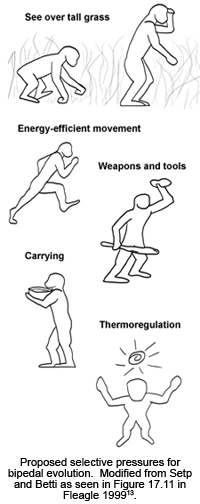 Habitual bipedalism is not necessarily the fastest and most effective form of running or walking, but bipedalism has a number of advantages over certain specialized forms of quadrupedalism. It is not clear why early hominins adapted a bipedal behavior. However, many hypotheses propose that environmentally-based selection pressures operated to drive the evolution of bipedalism8-10,12-14. As forests receded due to climatic conditions, hominins began to venture out into the expanding savannas where standing up to see over the tall grass aided in survival.
Habitual bipedalism is not necessarily the fastest and most effective form of running or walking, but bipedalism has a number of advantages over certain specialized forms of quadrupedalism. It is not clear why early hominins adapted a bipedal behavior. However, many hypotheses propose that environmentally-based selection pressures operated to drive the evolution of bipedalism8-10,12-14. As forests receded due to climatic conditions, hominins began to venture out into the expanding savannas where standing up to see over the tall grass aided in survival.
Older hypotheses about bipedal origins include the ability to carry food or other portable items over longer distances; the freeing of forelimbs for foraging, tool use, or protection; moving more energy-efficiently than other forms of primate quadrupedalism; and the development of long distance running. Another possible explanation for bipedalism is as an adaptation to efficiently cool the body in hot temperatures, known as thermoregulation. In a hot savanna environment a tall, lean upright posture exposes less surface area to the sun’s heat overhead, while also promoting heat loss by exposing the greatest amount of surface area (i.e. the sides of the body) to cooling winds and air.
Despite a lack of consensus about the origins of bipedalism, many if not most of these proposed hypotheses are not mutually exclusive. Some combination of different selection pressures may have been responsible for driving bipedal evolution.
eFossils is a collaborative website in which users can explore important fossil localities and browse the fossil digital library. If you have any problems using this site or have any other questions, please feel free to contact us.
Funding for eFossils was provided by the Longhorn Innovation Fund for Technology (LIFT) Award from the Research & Educational Technology Committee (R&E) of the IT governance structure at The University of Texas at Austin.
